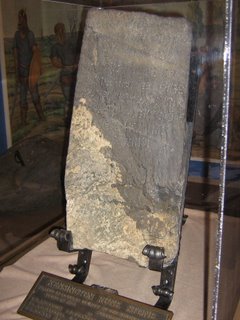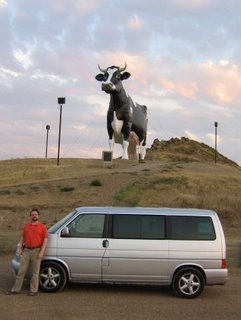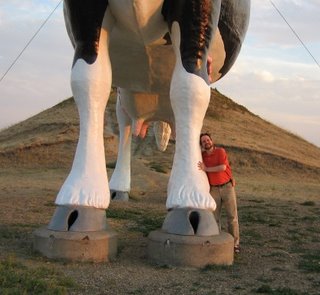Mileage: 1933
Composed Thursday night, 8/17
Sorry this is late; the motel we're staying at has no internet access, so I will have to upload later. Plus, believe it or not, the power just went out. It is dark in the middle of North Dakota at night with no electricity. (Fortunately, the iBook battery is fully charged, so I can do today's entry while it's fresh in my mind.)
We woke up this morning in lovely Alexandria, MN and high-tailed it to the Runestone Museum. This museum houses the Kensington Runestone: a stone, covered in runes, discovered in 1898 in the town of Kensington (hence the name). Runes, you may recall, are Norse letters. When the Kensington runes were translated, they told the story of a group of 14th century Norse explorers who had come to the Americas to trade with the natives. The inscription is dated 1362 CE, which puts it more than a century before Columbus.

There's controversy about the Kensington Runestone; many people say it is a forgery. However, the style of runes and the language are consistent with mid-14th century usage, including some details that were only uncovered in authentic Scandinavian inscriptions during the late 20th century -- a forger in the 1890s could not have known to include these details, you see.
The Runestone Museum contains various other artifacts that are clearly Norse, all discovered in Minnesota, Wisconsin, and surrounding areas. Some, especially wrought iron tools identical to authentic European ones, clearly came from Norse explorers. As the evidence mounts, the conclusion seems inescapable: the Norse were visiting the interior of North America at least a hundred years before Columbus.
And don't even get me started about the Mandan Indians, a pale-skinned, yellow-haired tribe that inhabited these parts....
Okay, if that wasn't enough (and it was), the Runestone Museum also includes a lot of other stuff from local history, including actual log cabins, a frontier-era store, a log church from the frontier period, and a one-room schoolhouse that was used into the 1940s. In addition, they have tons of Indian and frontier memorabilia, and a two-third scale model of a Viking longboat that they acquired from a traveling Smithsonian show. Oh, and there's a railroad caboose that you can walk through, too.
Needless to say, we were quite impressed by the Runestone Musuem.
Across from the Museum is a thrity-foot-tall statue of a Viking, which was constructed to stand in the Minnesota pavilion in the 1964 New York World's Fair. Affectionately known as "Big Ole," the statue is a lot of fun.

Before leaving Alexandria, we stopped in a liquor store and bought two bottles of local wine. We'll report on them when we drink them.
By 12:30 we were on the road again, We stopped briefly for gas in Fergus Falls, MN, where we chatted with some nice Canadian boys. Then we booked west on I-94, until we reached Fargo, ND. There, we passed a major milestone: we drove past the fold on our Rand McNally Road Atlas two-page map spread of the United States. Now, we were truly in the West. We celebrated by zipping through Fargo and on deeper into North Dakota.
You saw the update from the Apple Creek Rest Area.

By 5:20 or so we had reached lovely Bismarck, ND. We arrived just after the local history museum had closed. We chatted briefly with some costumed re-enactors who were loading their vehicles up in the parking lot -- they'd spent the day re-enacting the fur trade for school children. (I did not ask how much fur they got from each kid.)
We visited a local comics/collectors shop called Collector's Universe, which was very nice; I bought some comics and Thomas bought an autographed picture of Samuel L. Jackson as Mace Windu. Then we ate at the Woodhouse Restaurant, a diner-;ike establishment where you place your order by picking up a telephone handset at your table. The food was good, and the walnut-raisin pie was delicious (think of pecan pie, but with walnuts and raisins instead of pecans).
Back on the road, heading west, we crossed over the Missouri River, putting us in Mountain Time.
Along about 7:30, as the sun was westering, we came upon the town of New Salem and its star attraction, Salem Sue. Sue is a giant statue of a cow, which stands on an enormous rocky hill overlooking...well, overlooking absolutely everything for miles around. She was built in 1974 by the Lion's Club, at a cost of over $40,000. We took Eurovan up the hill, then dismounted and climbed further to admire Sue up close. Behind Sue the hill goes even higher, to a rock-strewn crown -- the whole thing rather resembles Weathertop in The Lord of the Rings, except of course Weathertop did not have a giant statue of a cow.


(You have to admire the person who stood on the side of that hill and said, "You know, what this place needs is a giant cow." Genius!)
And goodness, was it windy at the top of that hill. The wind comes in from the Great Lakes, and there's absolutely nothing to slow it down through all of Minnesota and two-thirds of North Dakota. We could see how some pioneers would be driven mad by the prairie wind....
One last note: the people of New Salem, unlike those at the Twineball, fully recognize what they have, and the local merchants have gotten with the program. At the gas station at the bottom of the hill, we were able to purchase Salem Sue postcards, a keychain, and a cloisonne pin. There were t-shirts, shot glasses, playing cards...the full panoply of tacky souvenir merchandise that one expects at such a major attraction.
Shortly after Sue, we turned left (south) on Highway 49. By now it was getting dark, Highway 49 is this two-lane road (paved, fortunately) that goes arrow-straight about 75 miles to South Dakota. Okay, it jogs slightly to avoid a huge lake. But mostly, it's straight. As we continued south, clouds were rolling in and we saw distant lightning to the west, lightning that was reddened by distance and (presumably) dust in the air. (Did I mention the wind?)
In the small hamlet of Elgin, we passed the Schatz Motel, which was open and advertising vacancies. A glance at the map told us that the next town, New Leipzig, was the last town before 30 miles of desolation and the South Dakota border. Well, we figured it was a good idea to stay in North Dakota, since South Dakota politics is so repulsive (why support such an obnoxious government with our tax money?) We continued to New Leipzig, which was a one-street town with many closed businesses, but no motel. So we turned around, went back to Elgin, and checked into the Schatz Motel.
No internet service (hey, our cell phones are out of service, that's how far in out in the sticks we are), but the room is lovely and we are glad to have a place to stay. We popped a Dr. Who episode into the iBook and watched it. By then the distant lightning was nearby, and it was softly raining. I started to work on this entry, and suddenly the power went out. Which brings us back to how dark it gets. Like, really, really dark. Not as dark as Cave of the Mounds when Trevor turned all the lights off, but pretty dark.
Ah, well, it's a litttle past midnight and the power just came back on, so I guess I should sign off. As soon as we have internet access, I'll upload this entry.
Tomorrow: South Dakota, the Badlands, Mount Rushmore, and beyond....
-Don

2 comments:
Don, the blogs are wonderful - you two are having an adventure!
And Thomas is just checking the (cough cough) hem of the vikings outfit right?
Loved the Judland Waste photo and want a copy of that one!!!
Yeah, hem of the outfit, that's the ticket....
We have plenty other pictures of Jedi Thomas wandering through the Badlands. In one, he's pointing off in the distance as if to say, "Mos Eisley Spaceport. You will never find a more wretched hive of scum and villainy...."
Post a Comment